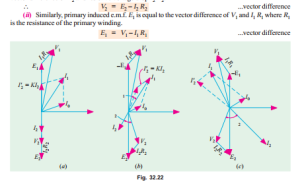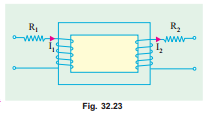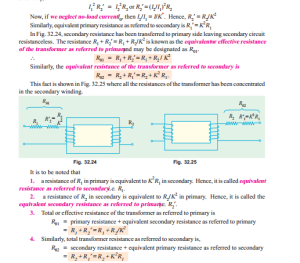Transformer with Winding Resistance but No Magnetic Leakage
An ideal transformer was supposed to possess no resistance, but in an actual transformer, there is always present some resistance of the primary and secondary windings. Due to this resistance, there is some voltage drop in the two windings. The result is that :
(i) The secondary terminal voltage V 2 is vectorially less than the secondary induced e.m.f. E2 by an amount I2 R2 where R2 is the resistance of the secondary winding. Hence, V 2 is equal to the vector difference of E2 and resistive voltage drop I2 R2.
The vector diagrams for non-inductive, inductive and capacitive loads are shown in Fig. 32.22 (a), (b) and (c) respectively.
Equivalent Resistance
In Fig. 32.23 a transformer is shown whose primary and secondary windings have resistances of R1 and R2 respectively. The resistances have been shown external to the windings.
It would now be shown that the resistances of the two windings can be transferred to any one of the two windings. The advantage of concentrating both the resistances in one winding is that it makes calculations very simple and easy because one has then to work in one winding only. It will be proved that a resistance of R2 in secondary is equivalent to R2/K
the equivalent secondary resistance as referred to primary.
The copper loss in secondary is I2 R2. This loss is supplied by primary which takes a current of I1.
Hence if R2¢ is the equivalent resistance in primary which would have caused the same loss as R2 in secondary, then
Note : It is important to remember that
(a) when shifting any primary resistance to the secondary, multiply it by K2 i.e. (transformation ratio)2.
(b) when shifting secondary resistance to the primary, divide it by K2.
(c) however, when shifting any voltage from one winding to another only K is used.
Magnetic Leakage
In the preceding discussion, it has been assumed that all the flux linked with primary winding also links the secondary winding. But, in practice, it is impossible to realize this condition. It is found, however, that all the V1 flux linked with primary does not link the secondary but part of it i.e. F completes its magnetic circuit by passing through air rather than around the core, as shown in Fig.
32.26. This leakage flux is produced when the m.m.f. due to primary ampere-turns existing between points a and b, acts along the leakage paths. Hence, this flux is known as primary leakage flux and is proportional to the primary ampere-turns alone because the secondary turns do not link the magnetic circuit of FL1.
The flux FL1 is in time phase with I1. It induces an e.m.f. eL1 in primary but not in secondary.
Similarly, secondary ampere-turns (or m.m.f.) acting across points c and d set up leakage flux FL2 which is linked with secondary winding alone (and not with primary turns). This flux FL2 is in time phase with I2 and produces a self-induced e.m.f. eL2 in secondary (but not in primary).
At no load and light loads, the primary and secondary ampere-turns are small, hence leakage fluxes are negligible. But when load is increased, both primary and secondary windings carry huge currents. Hence, large m.m.f.s are set up which, while acting on leakage paths, increase the leakage flux.
As said earlier, the leakage flux linking with each winding, produces a self-induced e.m.f. in that winding. Hence, in effect, it is equivalent to a small choker or inductive coil in series with each winding such that voltage drop in each series coil is equal to that produced by leakage flux. In other words, a transformer with magnetic leakage is equivalent to an ideal transformer with inductive coils connected in both primary and secondary circuits as shown in Fig. 32.27 such that the internal e.m.f. in each inductive coil is equal to that due to the corresponding leakage flux in the actual transformer.
X 1 = eL1/I1 and X 2 = eL2/I2
The terms X 1 and X 2 are known as primary and secondary leakage reactances respectively. Following few points should be kept in mind :
1. The leakage flux links one or the other winding but not both, hence it in no way contributes to the transfer of energy from the primary to the secondary winding.
2. The primary voltage V1 will have to supply reactive drop I1X 1 in addition to I1R1. Similarly E2 will have to supply I2 R2 and I2 X 2.
3. In an actual transformer, the primary and secondary windings are not placed on separate legs or limbs as shown in Fig. 32.27 because due to their being widely separated, large primary and secondary leakage fluxes would result. These leakage fluxes are minimised by sectionalizing and interleaving the primary and secondary windings as in Fig. 32.6 or Fig. 32.8.





